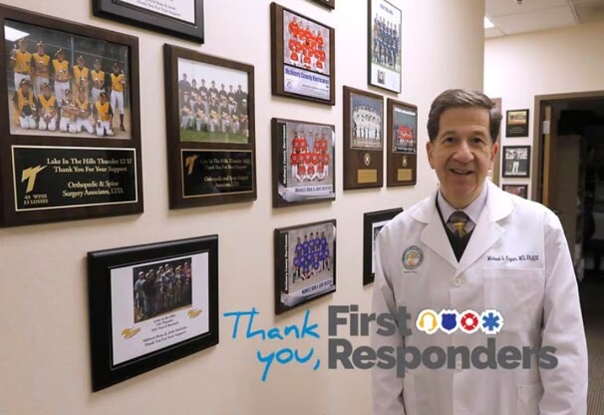Shoulder Pain & Common Shoulder Problems
- Category: Blog
- Posted On:
- Written By: James Seeds, MD
If you have shoulder pain, you’re not alone. According to the American Academy of Orthopedic Surgeons, nearly 7.5 million visits were made to physician offices due to shoulder problems in 2006. More than 4.1 million of these visits were for rotator cuff issues.
The good news is the vast majority of shoulder issues can be resolved using conservative (non-operative) treatments such as physical therapy, anti-inflammatories (Advil®, Tylenol®, Aleve®), or injections. When surgery is the only option, the prevalence of shoulder issues has led to significant advancements in minimally invasive shoulder surgery. Procedures that once required large “open” incisions are now performed though tiny incisions using an arthroscope. To patients, this means less time under anesthesia, little or no hospital stay, shorter recovery times and improved results.
The ABC’s of the Shoulder
The shoulder is the most mobile joint of the body. But, with this large range of motion comes an increased risk of injury. If you look at the boney anatomy of the shoulder, it is much like a golf ball (the head of the humerus bone) sitting on a golf tee (the glenoid). To provide stability, there are three structures that help the ball remain centered on the tee. These are called the labrum, the capsule and the rotator cuff. The labrum is a curb-like edge on the rim of the golf tee that prevents the ball from falling off. The capsule and rotator cuff keep the ball centered on the tee. When any of these structures is injured, the ball can wobble or fall off the tee, leading to shoulder pain.
Causes of Shoulder Pain
To many people’s surprise, most shoulder injuries are not caused by a specific incident. Many issues develop over time from performing a repetitive motion such as playing tennis, throwing a ball, painting, or doing yard work. Age is also a significant factor. As we age, the tendons of the shoulder weaken and years of wear and tear make us more susceptible to injuries. Rotator cuff tears, for instance, are much more likely to occur after the age of 40. Many times, people try to work through the pain, causing further damage. Therefore, a minor issue becomes a major injury that requires surgery.
Most Common Shoulder Issues
Tendinitis/Bursitis/Impingement Syndrome: All of these terms are used to describe an overuse injury that inflames the tendon, but does not tear it. These injuries come on gradually and because of continued use (or overuse), the symptoms get worse. If caught early, these conditions can be successfully treated without surgery. If the condition is ignored, they can lead to a rotator cuff tear. Most rotator cuff tears do not heal on their own; they tend to get worse with time. Because of pain, some people try to limit the usage of their shoulder, which can lead to another condition commonly called “Frozen Shoulder”.
Rotator Cuff Tears: The rotator cuff is a group of four muscles and tendons that work together to give the shoulder stability and help control the joint during rotation. As you age, the tendons in the shoulder weaken, therefore increasing your chance of injury. Problems with the rotator cuff muscles and tendons can lead to chronic shoulder pain and disability.
Younger patients tend to have more issues with shoulder stability. The structures at greatest risk are the labrum (curb on the golf tee) and the capsule (stabilizing ligaments). If the labrum is torn, the golf ball is no longer supported on the tee, which can lead to shoulder instability and dislocation. The biceps tendon, also inside the shoulder joint, can contribute to shoulder issues in people of all ages.
Common Symptoms & Complaints
Pain patterns and symptoms can be the same for various shoulder conditions. Therefore, it is important to see a Board-Certified Orthopedic Surgeon to get a proper diagnosis.
Typical complaints:
- Pain running down the side of the arm (including the elbow and forearm)
- Difficulty sleeping (due to pain)
- Arm weakness
- Pain when reaching backwards
- Inability to lift the arm above the head
- Loss of motion
- Feeling like the shoulder is slipping out of place
Shoulder issues can be the source of intense pain and cause people to stop participating in sports and activities. Because of medical advancements, people no longer have to live with the discomfort of a shoulder injury. If you’re experiencing shoulder pain, get it checked. Early diagnosis and treatment is the key to a fast recovery and return to a pain-free lifestyle.
James R. Seeds, MD holds a double board certification in both Orthopeodic Surgery and Sports Medicine. He was fellowship trained in Sports Medicine at the American Sports Medicine Institute (Birmingham, AL) in the company of internationally renowned surgeons Dr. Lawrence Lemak and Dr. James Andrews. Dr. Seeds is a partner at the Midwest Bone & Joint Institute (Algonquin, Barrington, Elgin and Geneva, IL).


